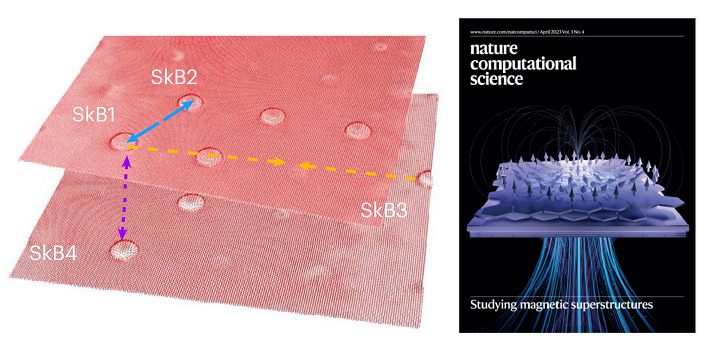Capturing the Mysterious Moiré Magnetic Exchange Interactions
(By B. Yang, Y. Li, H. J. Xiang, H. Q. Lin, and B. Huang)
Whereas conventional magnets undergo a few simple magnetic exchange interactions, moiré lattices in twisted magnets could induce large-scale periodic magnetic exchange interactions with more than tens of thousands of nonequivalent magnetic parameters, forming complicated moiré magnetic exchange interactions (MMEIs). For instance, to model the moiré magnets at θ ~ 1°, one should account for > 20,000 atoms for a moiré supercell and the resulting number of MMEIs reaches to > 400,000. “More is different”, as stated by Philip Anderson in 1972, indicating the uniqueness of MMEIs in generating new magnetic phenomena. Unfortunately, owing to extreme complexity and twist-angle sensitivity, MMEIs in twisted magnets have never been understood. As a result, many puzzling experimental observations have been made on the complex spin textures and magnetic phase transitions in twisted magnets.
In a recent study, B. Huang in collaboration with H. Q. Lin and H. J. Xiang (Fudan University) made a key step towards understanding the long-standing mystery of MMEIs. First, they develop a simple but powerful sliding-mapping approach to effectively capture the MMEIs. Then, they set up a microscopic moiré spin Hamiltonian that enables the description of magnetic structures induced by the MMEIs. Remarkably, they discover that the emergence of MMEIs can create an unprecedented magnetic skyrmion bubble (SkB) with non-conversed helicity. They name it as moiré-type SkB. Interestingly, the SkB can form an unusual frustrated bilayer-lattice, indicating new physics may be generated in this SkB lattice. Importantly, the size and population of SkBs can be finely controlled by twist angle, a key step for skyrmion-based information storage and quantum computing. Finally, they reveal that the MMEIs can be effectively manipulated by the substrate-induced interfacial Dzyaloshinskii-Moriya interaction, modulating the twist-angle-dependent magnetic phase diagram, which solves the outstanding disagreements between prior theories and experiments.
This work has recently been published in Nature Computational Science [1]. Prof. D. Soriano at Universidad de Alicante (Spain) highlights that “these computational advances are a huge step towards a more realistic picture of the physics of materials” in the News and Views [2]. In addition, this work is also selected as the cover of the journal and featured by the editors [3].
References:
[1] Baishun Yang, Yang Li, Hongjun Xiang, Haiqing Lin, Bing Huang, Moiré Magnetic Exchange Interactions in Twisted Magnets, Nat. Comput. Sci. 3, 314 (2023).
[2] David Soriano, Uncovering magnetic interactions in moiré magnets, Nat. Comput. Sci. 3, 282 (2023).
[3] Editorial, Computationally probing moiré magnets, Nat. Comput. Sci. 3, 277 (2023).

Figure: Computationally probing moiré magnets.



